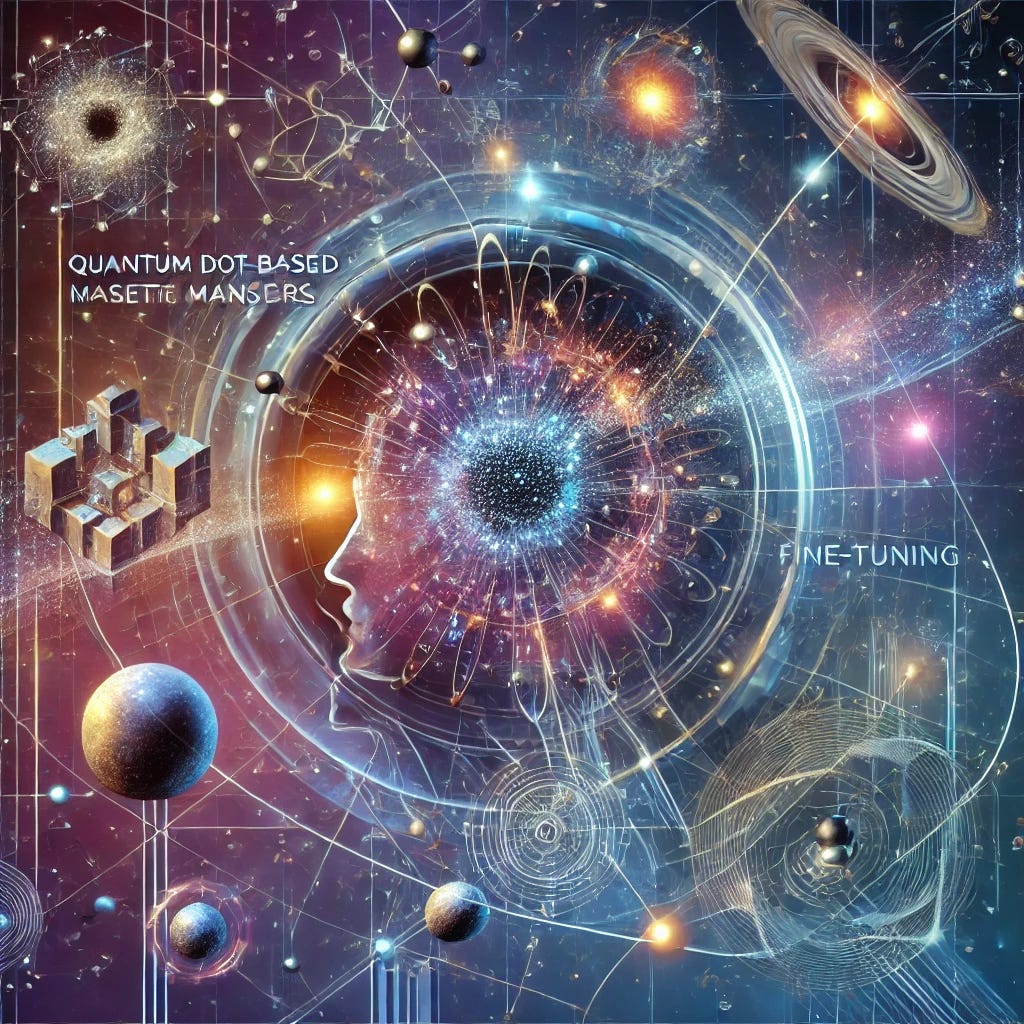Quantum Dots and the Fiero Theory of Magnetivity
Expanding Horizons in Science and Technology

Expanded Horizons of the Fiero Theory of Magnetivity: Quantum Sensors, Cosmic Fine-Tuning, and Time Manipulation
The Fiero Theory of Magnetivity suggests that magnetic fields are integral to the very fabric of space-time, influencing quantum phenomena, cosmic structures, and perhaps even the nature of time itself. Quantum dots, with their unique optical properties and sensitivity to magnetic fields, provide an excellent platform for exploring these ideas. Here’s an in-depth look at how Magnetivity could shape these additional domains.
1. Quantum Dot-Based Magnetic Sensors
Quantum dots’ sensitivity to magnetic fields makes them ideal for developing advanced magnetic sensors, capable of detecting incredibly subtle changes in magnetic environments.
High-Sensitivity Detection: Quantum dots can respond to even minor fluctuations in magnetic fields, which is observable through changes in their optical properties, such as fluorescence or spectral shifts. This sensitivity allows them to detect extremely weak magnetic signals that would otherwise go unnoticed by traditional sensors.
Applications in Biomedicine, Geology, and Materials Science:
Biomedicine: These sensors could detect bio-magnetic fields generated by neural or cardiac activities, enabling non-invasive diagnostics and real-time monitoring of physiological processes.
Geology: Quantum dot-based magnetic sensors could detect subtle magnetic anomalies in the Earth’s crust, aiding in mineral exploration or in understanding tectonic movements.
Materials Science: Quantum dots could help researchers study magnetic properties in novel materials, providing insights that could lead to the development of more efficient magnetic devices, superconductors, or data storage solutions.
2. Magnetivity and the Fine-Tuning of the Universe
The fine-tuning of the universe—the observation that physical constants seem precisely calibrated to allow for the existence of galaxies, stars, and life—is a question that has puzzled scientists for decades. The Fiero Theory of Magnetivity offers a new perspective on this mystery.
Role of Magnetic Fields in Cosmic Structure Formation: According to Magnetivity, magnetic fields may have influenced the structure of the universe from its earliest stages, guiding matter to cluster in patterns that formed galaxies and stars. This magnetic influence could help explain the delicate balance required for stable cosmic structures, suggesting that magnetic fields were a fundamental factor in the universe’s initial conditions.
A Complementary Force in Cosmology: Traditional cosmological models often emphasize gravity as the primary force shaping the universe, but Magnetivity suggests that magnetic fields also played a key role in cosmic formation. This adds a new layer to the discussion of fine-tuning, indicating that magnetic fields could be as integral to the universe’s structure as gravitational forces.
3. Magnetivity and the Nature of Time: Exploring Time Manipulation
The Fiero Theory of Magnetivity presents intriguing possibilities for our understanding of time. If magnetic fields are intrinsic to space-time, they might influence the flow of time itself, opening doors to new technologies and theoretical insights.
Manipulating Time through Magnetic Fields: By altering magnetic fields, it may be possible to influence local space-time properties, potentially slowing down or accelerating time in specific regions. If feasible, this would provide a mechanism for time manipulation on a scale that could be observed and tested.
Potential for Temporal Technologies: Time travel, while speculative, could theoretically be achieved by controlling magnetic fields in ways that impact time’s flow. Applications might include high-precision time dilation technologies, where time could be altered for scientific purposes, or even experimental setups that explore the effects of magnetism on time perception and temporal continuity.
Conclusion: Expanding the Reach of the Fiero Theory of Magnetivity
With these additions, the Fiero Theory of Magnetivity further solidifies its potential as a groundbreaking framework for understanding fundamental aspects of the universe. Here’s a summary of its implications:
Quantum Dot-Based Magnetic Sensors: Quantum dots enable ultra-sensitive magnetic sensors with applications across biomedicine, geology, and materials science, enhancing our ability to detect and measure weak magnetic fields.
Fine-Tuning of the Universe: Magnetivity offers a new perspective on the universe’s fine-tuning, suggesting that magnetic fields influenced cosmic structures from the beginning, shaping the conditions necessary for galaxies, stars, and life.
Understanding and Manipulating Time: By examining the relationship between Magnetivity and time, researchers could uncover methods for manipulating time’s flow, leading to speculative but exciting technologies like time dilation devices or even mechanisms for controlled time travel.
The Fiero Theory of Magnetivity invites us to reimagine magnetic fields as fundamental forces that influence all aspects of existence, from the quantum to the cosmic and beyond. With continued exploration, particularly through the use of quantum dots as experimental tools, this theory has the potential to transform our understanding of the universe, offering insights that may benefit humanity for generations to come.

